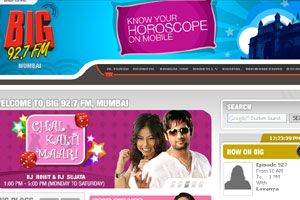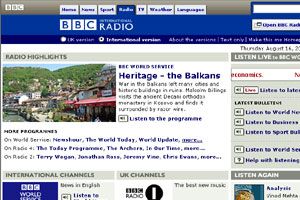



The Internet is the new frontier for India's burgeoning FM radio stations.
Almost every station that made its presence felt in phase II of FM in the country has a dedicated website, attempting to woo the youth TG with downloads, contests and blogs. Not surprisingly though, most of the websites look similar, argue industry observers, an allegation that?‹?“s carried over from the stations themselves. In the three years that FM has been allowed to grow, stations have not made adequate use of the medium, barring the odd experiment to consolidate the listenership, argue experts.
The scenario may soon change. Big FM recently launched a new website, complete with blogs, contests and even playlist requests. RED FM and Meow FM are getting ready to unleash interactive websites to bridge that gap between radio and the listeners. Radio City claims to have got an encouraging response to its Whatte Fun microsite. After nearly three years of existence, are radio players finally waking up to the potential of the Net?
"It?‹?“s sad that the FM industry is not using the Net to its fullest potential," rues veteran radio consultant Sunil Kumar. "At a time when the world is talking about going web 2.0 and social networking sites like Orkut claim to have more than 30 per cent of its members from India, Indian radio stations are just scratching the surface."
While Kumar agrees that the Radio One website and the Whatte Fun microsite have gone a step further in connecting with listeners, he says the efforts are not enough. "Being on the Net is about going to that place every day for something new. It should help me listen to the station better. In fact, the website should provide the same value that a listener expects from the station."
RED FM CEO Abraham Thomas agrees. "Websites are really important since the listenership is now turning from passive to an active medium. Hence, there needs to be some kind of interaction with the listeners. A website is the best platform for it."
Increasing interactity, but stress still on SMSSays Vishnu Athreya, VP Programming and Brand, Radio One, "We use our website for both, building up listenership as well as increasing interactivity. We can?‹?“t expect our listenership to increase because of the website, but yes, if they can communicate, check and download stuff they have been hearing on air, why won?‹?“t they continue to be loyal listeners?"
That is the general feeling across stations, but observers argue that the communication is restricted. Kumar says that hardly any website offers the facility to request the station for a song through email. The stress is always on SMS dependent contests and interactivity, which helps to push revenue for the station. Websites of Radio city, Big and Radio One have RJ blogs, polls, blogs and message boards (City has even started an audio blog), but the traffic is sparse. The interactivity is pushed through SMS (the Big site urges viewers to SMS jokes and ask for horoscopes), but the community seems to be getting developed more through neutral social networking sites like Orkut, where even the RJs (some more well known than the stations they belong to) have their own spaces. You Tube videos of events at stations proliferate such sites, and fan sites of radio jockeys are not an uncommon phenomenon on Orkut.
Net potential untappedElsewhere, radio stations are wising up to the tricks of the Internet trade. Earlier this year, Clear Channel Communications Premiere Radio Networks unit began marketing data on the most popular downloads from illegal file- sharing networks to help radio stations shape their playlists.
The theory is that the songs attracting the most downloads online also will win the most listeners on the radio, helping stations sell more advertising. In turn, the service may even help the record labels, because radio airplay is still the biggest factor influencing record sales.
Back home, Big FM?‹?“s new website has started allowing viewers to post their own favourite playlists, which will be collated into the most favoured ones and played back to back on the station. Such examples are rare. "Radio should be used to test new music," avers Kumar, whose company Big River Radio is helping a station in Chennai to publish new artistes on its website, and later featuring them on the station."It will feature a new artiste or a new song every day of the year and the music will be published only six months later, till which time it can be downloaded for free. That's how new artistes will be created," he says.
Mum on airWhile most stations agree that their TG hovers between the 18 - 35 age group, (which is also the TG that uses the Net the most), hardly any of the stations today actively promote their websites on their shows or on on air promos. Even Radio One, which bagged the Promax award for the best website in 2006, has been talking about its website only when it promotes its new college campus contest. Radio One has a special department at every city who handles their websites along with the marketing team who often helps in inducing elements since the website is a part of their marketing strategy. Their team includes a proper web team with web designers. Only the backend is outsourced, currently done by print sibling Mid-day. Even Radio city which plugs its Whatte Fun concept actively on air, rarely directs or exhorts listeners to log on to the website or even to the parent Radio City site or its parent, which in fact offers interesting snippets of its Babbar sher and kya keh raha hai properties.
Gimme local!With an increasing presence in the smaller metros, radio stations should ideally begin to address local issues and offer local information on dining out, shopping and other facilities through their websites, says Kumar. Currently, apart from Radio One?‹?“s RJ Malini?‹?“s show which asks readers to write in with freebies offered in Mumbai, there is scarcely any website that can be accessed for information on a city.
Content with contentMost stations feature their radio jockeys and the shows they host.Feedback generated is used to tweak content accordingly, say programming heads, who need to keep a finger on the pulse of the site.
Athreya says Radio One?‹?“s out-of-the-box experiment with BBC minutes has been appreciated by the audience as understood through the website. The station now plans to include BBC minutes on the web as well, content that gets refreshed every time it is been aired. Explains Athreya, "Websites generate a lot of feedback from the ones who are listening to us. It helps us in fine-tuning our programs and not exactly tailoring it. We will never change a program because of the feedback, but yes we fine tune it as per the feedback."
Thomas agrees, "Although the web isn't very active today as far as radio is concerned, it is a growing segment and the ones who capture it today will definitely have an edge over the others."